| Release List | Reviews | Price Search | Shop | Newsletter | Forum | DVD Giveaways | Blu-Ray/ HD DVD | Advertise |
| Reviews & Columns |
|
Reviews DVD TV on DVD Blu-ray International DVDs Theatrical Reviews by Studio Video Games Features Collector Series DVDs Easter Egg Database Interviews DVD Talk TV DVD Talk Radio Feature Articles Columns Anime Talk DVD Savant HD Talk Horror DVDs Silent DVD
|
DVD Talk Forum |
|
|
| Resources |
|
DVD Price Search Customer Service #'s RCE Info Links |
|
Columns
|
 |
Clark Gable - The Signature Collection: |
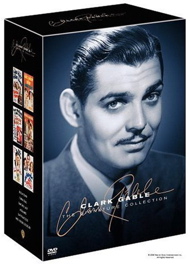
Clark Gable - The Signature Collection Warner DVD 1:37 flat full frame Street Date June 20, 2006 Reviewed by Glenn Erickson |
Clark Gable, King of the movie stars, reigned in Hollywood from about 1934 to 1940, and could almost do no wrong. As the perfect leading man he was adored by women and equally popular with men. Although he escaped the MGM studio once or twice for the exceptional hit It Happened One Night and the epochal Gone With the Wind, Gable spent most of his pre-1950s career playing the Louis B. Mayer game, grinding out safe entertainments guaranteed to increase his popularity and result in a commensurate rise in the fortunes of Leo. In reality, although few of his pictures are timeless classics, many are solid entertainments. Even his lowliest vehicles are eminently watchable.
Warners' Signature Collection of Clark Gable pictures gives a light overview of his career, from playing opposite Joan Crawford on an equal basis to easily outweighing a pair of relative youngsters, Ava Gardner and Grace Kelly, twenty years later. The collection is also a good opportunity to see Gable in harness for a range of directing talent -- from studio contract men to tough guys like John Ford. Gable makes all of them look good.
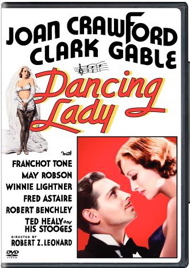
Dancing Lady
1933 / B&W / 92 min. / Available separately at 19.98
Starring Joan Crawford, Clark Gable, Franchot Tone, May Robson, Winnie Lightner, Fred Astaire, Robert Benchley, Ted Healy, Nelson Eddy, Sterling Holloway
Cinematography Oliver T. Marsh
Art Direction Merrill Pye
Film Editor Margaret Booth
Special Effects Slavko Vorkapich
Written by Allen Rivkin, P.J. Wolfson, David O. Selznick from a novle byJames Warner Bellah
Produced by
Directed by Robert Z. Leonard
This backstage saga is clearly a retrench-and-counterattack against Warners' overwhelming success with grandiose musicals. Although it can't compete in music or choreography, Gable and earnest showgirl Joan Crawford compensate in the star personality category. And it can boast the modest screen debut of Fred Astaire!
Typical of MGM, Dancing Lady has more "class" appeal than the proletarian, socially conscious Warner musicals. A Golddiggers picture typically concentrates on the problems of chorus girls, but this movie barely informs us that Patch Gallagher's entire company of chorines is slaving away "on spec," rehearsing for nothing in hopes of being in a hit. When über-jerk Tod Newton folds the show for the convenience of his love life, this script (David O. Selznick had a hand in it) doesn't waste much time with the little people.
Having more class means that Dancing Lady concentrates on the winners. Hopeful Janie gets her break after a montage of failure and is soon part of the nightclub life in designer dresses and oh-so-perfect hair. How she manages this after working like a sweathog all day, we don't know. MGM's idea of class -- rich surroundings, singing back-up for the tenor at the big party ("Everything I have is yours...') private swimming, a trip to Havana -- has dated somewhat, but works well enough.
The mechanics of this backstage musical are sound. Gable is no Warner Baxter but he runs a tight ship and has to put up with weasely moneymen that aren't as comical as the clowns in Busby Berkeley's movies. Gable's sidekick is Ted Healey, who brings his Stooges along as stagehands and piano accompanist. They're a flop, hampered by a format that doesn't allow them to do their usual violent mayhem.
Fred Astaire shows more class than anybody, and dances well with Crawford by toning down his act to what she can perform. They fly away to Bavaria on a magic carpet (?) for a lively polka number. Crawford's an okay dancer but in at least one number lets her elaborate costume do her dancing for her. She's energetic in a style that's more like 1925 than 1933 .... but still passable - good. Interestingly, when her show is raided she meets Franchot Tone over a handout meal much like Naomi Watts in the new King Kong.
May Robson and Winnie Lightner are rich and poor comic relief, respectively. Robert Benchley is somewhat annoying sandwiched into a colorful part as a jaded and annoying Broadway columnist. Sterling Holloway turns up as a vocal, incompetent playwright and Nelson Eddy kicks off the big musical number at the end, "Rhythm of the Day," where some clever effects transmute swells from the 1700s into 1930s swingers.
The musical numbers strive for Berkeley effects, including overhead shots and fast-moving street action coordinated into the choreography. They mostly fall short but "Rhythm of the Day" has appeal in its effects and Crawford being used as icing instead of holding front row center. The art directors and (I presume) special effects maestro Slavko Vorkapich provide some terrific visuals for the last number, including a phantasmagoric carousel and a kaleidoscope of female figures ... a visual rotoscoped much later for use in the animated Beatles movie Yellow Submarine.
Gable is solid as the tough Patch Gallagher. He really tells Janie to buzz off in the early scenes and warms up to her with a minimum of cute or coy trickery. Of course, the lame story enforces unnecessary misunderstandings of the kind that require that people be dishonest with each other, so as to create mistaken notions for "true love" to overcome. Yes, it works, but on a pea-brain level.
Dancing Lady looks great for a movie that was probably playing not long after King Kong was released; the restored sound makes the musical numbers slick or punchy as intended. One short subject is a grating showcase for the charmless Ted Healey and his Three Stooges, and the other teams just one Stooge (Curley) with a different comic for a 2-Strip Technicolor comedy with some really strained jokes. A trailer rounds out the package. Except for the well-appointed San Francisco, these Gable pix run light on new featurettes, which is not a bad thing -- some of the offerings cobbled together for the last couple of batches of musicals were rather generic.
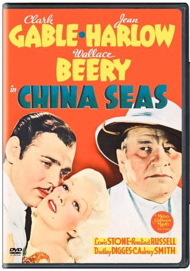
China Seas
1935 / B&W / 87 min. / Available separately at 19.98
Starring Clark Gable, Jean Harlow, Wallace Beery, Lewis Stone, Rosalind Russell, C. Aubrey Smith, Robert Benchley
Cinematography Ray June
Art Direction Cedric Gibbons
Film Editor William LeVanway
Original Music Herbert Stothart
Written by Jules Furthman, James Kevin McGuinness from a book by Crosbie GarstinCrosbie Garstin
Produced by Albert Lewin
Directed by Tay Garnett
They must have called this one Grand Hotel on the Cathay Main, but it's also sort of a re-run of Red Dust with old smoothie Gable decked out in nautical whites and romancing two femme stars for the price of one. A quick look at the billing lets us know which breathless beauty wins the pair of big ears with a hunk between. Tay Garnett's direction is by the book but this one has enough excitement and variety to keep the pot boiling.
Add Shanghai Express to the list of influences on this romantic adventure. Jean Harlow, her sex quotient dialed down about 30% to please the censors, is still a handful to contend with and does her best to play a loudmouthed tramp made legit by the depth of her love for her seagoing hero Clark. A pre-Screwball Rosalind Russell plays straight-woman to Harlow's floozie; both contribute pro-level work.
The only question we have is why Gable falls for either of them. Russell's evah-so-refined old girlfriend is all restraint and no fireworks -- they resisted cheating on her husband when he was alive and now have an illusion that they can pick up the pieces again. But it's just a bloodless exchange of glazed eyes.
As for Harlow's China Doll, she's presented as a dangerous loose cannon that goes emotionally berserk when deprived of her man. She abets a pirate takeover that results in multiple horrible deaths, and gets off the hook because she was "upset" -- even Gable's Captain Gaskell uses a flimsy technicality to excuse her crime ("I tried to tell ya but ya wouldn't listen!'). The movie subscribes to the theory that women are infants and not responsible for what they do.
The colorful supporting cast is a fringe benefit. It's fun to watch Akim Tamiroff seduce an unfaithful wife over a string of pearls; he's engagingly slimy. Edward Brophy (who loses his head to the guillotine and his hands to Peter Lorre in the upcoming Mad Love) is a fun passenger, while unbilled Hattie McDaniel gets better lines than most of the legit cast. C. Aubrey Smith is more animated than usual and acts with more than his voice and his nose. The only disappointment is Robert Benchley again, who just hasn't aged well as a ditzy drunk. It must be the material, as he's absolutely top-notch five years later in Hitchcock's serio-comedy Foreign Correspondent.
Wallace Beery is really a co-star and he's earned praise for this performance, but I think he's just terrible, ham all the way. It's odd whom one chooses to discriminate for and against without an appreciation of their full worth but Beery just doesn't make it for this reviewer. Just seeing Harlow even sit down at a table with this boozy clod is unpleasant. And there isn't a line he can't make seem fake.
Lewis Stone is pretty feeble in a major role as a Lord Jim-type outcast who gets his chance to go back to sea, screws up again, and then redeems himself in a ridiculous act of bravery and self-sacrifice. The violent pirate attack scene is tense right up through Stone having his ankles shattered with a hammer (yikes). He then saves the day by climbing, crawling and rolling himself around the decks and stairways in a manner that would be patently impossible for a guy with that particular injury. It's an okay scene, but really ...
Tay Garnett keeps the heat on for the twin romances and makes sure to underscore Gable's virility in the standard ways -- gruff talk, smooth manners and general T-shirt appeal (gotta please the fans from his Capra movie). The movie is tightly constructed and sharply paced.
China Seas is really good-looking; materials must have been in fine shape on this title. Herbert Stothart's score is forgettable but the mix is peppy -- almost all the Warners-optimized tracks are a pleasant surprise.
Two Oriental-themed travelogs and a musical short A Girl's Best Years will make okay viewing for the curious; if one of these TravelTalk featurettes has some amazing nugget buried near the end, someone please tip Savant off as I rarely get more than halfway through. A trailer is on this one too ... it lauds China Seas as a timeless classic, a ploy MGM used on about 50% of its pictures.
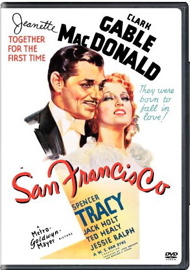
San Francisco
Warner DVD
1936 / B&W / 1:37 flat full frame / 115 min. / Street Date June 20, 2006 / 19.98
Starring Clark Gable, Jeanette MacDonald, Spencer Tracy, Jack Holt, Jessie Ralph, Ted Healy, Shirley Ross
Cinematography Oliver T. Marsh
Art Direction Cedric Gibbons
Montage Slavko Vorkapich
Special Effects James Basevi, Russell A. Cully, A. Arnold Gillespie, Loyal Griggs
Film Editor Tom Held
Original Music Nacio Herb Brown, Walter Jurmann, Bronislau Kaper
Written by Anita Loos from a story by Robert Hopkins
Produced by John Emerson, Bernard H. Hyman
Directed by W.S. Van Dyke
Savant has reviewed this picture separately, at this address.
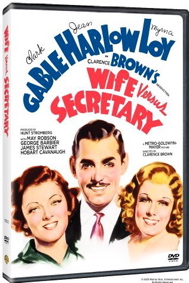
Wife versus Secretary
1936 / B&W / 87 min. / Available separately at 19.98
Starring Clark Gable, Jean Harlow, Myrna Loy, May Robson, George Barbier, James Stewart, Gloria Holden
Cinematography Ray June
Art Direction Cedric Gibbons
Film Editor Frank E. Hull
Original Music Herbert Stothart, Edward Ward
Written by Norman Krasna, John Lee Mahin, Alice Duer Miller story byFaith Baldwin
Produced by Clarence Brown, Hunt Stromberg
Directed by Clarence Brown
An expert star vehicle, Wife vs. Secretary is the best and worst of mid-30s MGM filmmaking. It's slick and smart, with a production sheen that other studios could envy. It also has three diamond-hard star performances that must have made it the tops for fashionable entertainment in 1936. But there's the downside as well. The story is an elitist screed that assumes that only the wealthy really matter, and even more troubling, the whole film seems to have been constructed as a defense for the privileges of the "big businessman" -- ignorant outsiders jump to the conclusion that Clark Gable's ambitious executive is an irresponsible philandering liar. Fat cats just don't get no understanding at home.
With Norman Krasna contributing to the script, Wife vs. Secretary shapes up as a snappy soap opera among the high-powered business elite in New York's skyscrapers. Gable's Van runs a top publishing company and the film sides 100% with his ambitions and needs. It's a refined game played between just a few top executives and we're given to understand that it requires nerve, quick decisions and secrecy. Gable wants to buy another publication, a quest that requires him to spend a lot of late nights and take sudden clandestine meetings with his top Girl Friday, Jean Harlow's Whitey.
Naturally, there is plenty of circumstantial evidence to point suspicion at poor faultless, innocent Van. He and Whitey have to squeeze into a hallway phone booth together to avoid going through the company switchboard for a crucial phone call. All those late nights together are sincerely being used to prepare business proposals. Eventually, they secretly sneak off to Cuba together -- but it's only to cinch the big deal. He's in her room for the most innocent of reasons, no matter what the office gossip might be.
Myrna Loy's devoted wife Linda spends two-thirds of the film convinced that her Van is telling her the truth, only to have her faith shaken by a suspicious mother, a vindictive friend (played by Gloria Holden, Dracula's Daughter) and mounting evidence. Linda is the model wife: Her vocation is "society hostess" and she's sheltered from the tough decisions Van makes at the office. On the other side of the triangle is a young James Stewart as Whitey's frustrated boyfriend Dave. Dave can't understand why his platinum blonde girlfriend doesn't want to drop her exciting job (where she is indeed a marvel of organization), marry him and become a working-class hausfrau ... definitely not at Linda's silk & butlers level.
Here of course is where the movie goes haywire. Overheated Hollywood soaps of the time really cooked the characters to come up with "poignant" reasons for misunderstandings that can lead to separation and the inevitable reconciliation. The first rule is that nobody just comes out with the truth about their feelings. Linda hides her fears from Van, while Van treats her like a dunce, not wanting to "disturb" her with the complications of his job. Whitey obviously has subterranean desires for her boss, and can perhaps be forgiven for keeping those under wraps. Yet she makes no move whatsoever to maintain proprieties. They're always together in and out of the office. She uses his private car and does nothing to allay office wags as to their true relationship. Frankly, although the characters all sort their lives out at the end, they remain strangers, even the husband and wife. Relationships are supposed to be based on some intangible "magic," and not any kind of sharing of honest thoughts.
Wife vs. Secretary's message is that perfectly honorable executives only look like adulterous swine; they're really true-blue through and through. I know I've been laying on the black thoughts about Louis B. Mayer lately, but Wife vs. Secretary really plays as though it were green-lit so that ol' Louis could use it as propaganda in his relations at home. Dated movies often blame Mame for the evils of the world, and here the female sex is indicted for not having absolute faith in their flawless men. This idea would be expanded to ridiculous extremes in Claire Booth Luce's nauseating The Women, where a wife goes through Hell and the trials of Job to be sufficiently 'deserving' of her adulterous husband's "love." Wife vs. Secretary wraps up predictably: All the women go back to their assigned roles and the male's prerogative is untouched.
There's no denying that Wife vs. Secretary is a fun show. Gable's work shows even more self-confidence than in the previous picture, although he's not the natural guy we met in his Capra fling. Jean Harlow plays an intelligent woman for a change and isn't bad at all; if she'd lived long enough to take on more variety in her roles she'd have probably turned into a good all-round actress. Myrna Loy is the big loser. She's great as always but the film makes her into a self-pitying ninny. Her really worthwhile roles were in the future.
Warners' DVD of Wife vs. Secretary looks sharper than the earlier Gable pictures; I was once told that camera film stock went through a major improvement in 1935 or so, and the pictures started to look better. On the other hand, MGM's posters suddenly started looking terrible, just head portraits that barely resembled the stars, on a white background.
The extras on this disc (see below) are an energetic musical and a Crime Does Not Pay episode called The Public Pays. The Crime Does Not Pay shows always cracked me up. More often than not a sober announcer would introduce a "real" elected official or police bigwig, and we'd cut to a recognizable contract bit player. A gushy trailer wraps up the package.
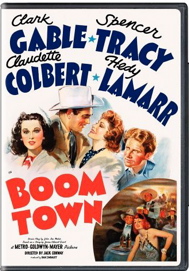
Boom Town
1940 / B&W / 119 min. / Available separately at 19.98
Starring Clark Gable, Spencer Tracy, Claudette Colbert, Hedy Lamarr, Frank Morgan, Lionel Atwill, Chill Wills, Minna Gombell
Cinematography Harold Rosson, Elwood Bredell
Art Direction Cedric Gibbons
Film Editor Blanche Sewell
Original Music Franz Waxman
Written by John Lee Mahin story byJames Edward Grant
Produced by Sam Zimbalist
Directed by Jack Conway
If Wife vs. Secretary plays like a sneaky ploy to rationalize executive philandering, Boom Town is MGM's ode to capitalist entrepreneurship. The moguls considered themselves gamblers and liked to picture themselves as an elite boys' club that played by a code of conduct, when they were really dog-eat-dog opportunists. Boom Town's All-American heroes play a little wild sometimes but underneath they're true blue -- and the script wants us to think that their insatiable greed is the juice that keeps America humming.
1Boom Town was a big show with a big promotion. Ads show the four stars walking arm in arm on a treadmill, all puffed up and ready to fill America with their smiles. Louis B. Mayer perhaps wanted some of Gable's Gone With the Wind aura to rub off -- the main cast titles slide on-screen like the main title in Selznick's picture.
Boom Town is an ode to energy and ambition that now plays like a parody of the American dream. Wildcat oilmen Gable and Tracy cheat and steal when they're pals and hold a miserable grudge when they're at odds with one another. They start off like Robin Hood and Friar Tuck on a plank across a sea of Texas mud. They go bust. They get rich. One steals the other's girl, accidentally, of course: Neither really has a mean bone in his body. When one is rich, the other refuses his help out of pride. Next season, roles reverse and so do the attitudes.
The authors have put the thinnest of glosses on the two stars' established personae. Tracy's Sand is slightly more of a mensch due to his suffering over the lost Claudette Colbert. Gable's McMasters is a bullheaded guy who makes a 'big mistake' in love but is really innocent at heart. Any resemblance to real people is illusory. They are, however, an entertaining bunch. The women have a harder time making anything believable, but the only scene that defeats them is a hilarious trip to a refinery wearing fine dresses. As everything they touch would be filthy and the air permeated with noxious gases (ever been within two miles of refinery?) the ladies would have to burn their clothes as soon as they got home, and wash their hair six times. I smell a "make the oil industry look rosy" rat here.
Boom Town has a big dose of righteous nonsense when Sand takes it upon himself to mix into McMasters' business and marriage at the same time. Colbert gives him carte blanche to go do whatever it takes to solve the situation, and Sand tries to force McMasters and Lamarr's slinky Dutch girl to hook up for real, so that Colbert will be free to marry him. Now how altruistic is that?
The ending is a giant defense of reckless business practices. Yes, McMasters saved his company by illegally forming a combine of oil producers and refiners, but he's just doing his thing -- he's really a noble victim when the Federal Investigators take him to court. Of course, once the trial is underway the prosecutors exclusively use character assassination techniques, and San and others come to McMasters' aid with patriotic speeches. If that isn't Mayer & Co. drumming up sentiment to "let business run free", I don't know what is.
Colbert is delightful as usual, while Lamarr seems too ethereal to be interested in any of these humans, even Gable. Frank Morgan is a wishy-washy jerk equipment supplier, and Chill Wills the sheriff who hates to shoot so many thieves and instead becomes a cook and babysitter for McMasters' son. Lionel Atwill is McMasters' main New York competitor, before trickster Lamarr shows McMasters an inside track.
This is probably considered a big-deal Gable picture, but I think that by this late date MGM was just wasting his considerable talent.
The DVD of Boom Town is in practically perfect condition. MGM may have "dream factoried" all the life out of its product by 1940, but they sure knew how to give a picture a technical polish. The sound is also punchy, especially in an early scene where the two heroes put out a dangerous oil well fire.
The featurettes this time out are a "Hollywood Hobbies" stars' home tour bit of fluff that wants us to believe that shots of Clark Gable chopping wood are new footage and not outtakes from some movie in production. Home on the Range is one of those Technicolor Rudolf Ising cartoons, the ones that put everyone but animation fanatics to sleep. Why am I mentioning the trailer when I could have said they all have trailers?
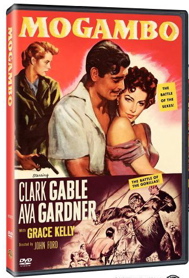
Mogambo
1953 / Color / 116 min. / Available separately at 14.98
Starring Clark Gable, Ava Gardner, Grace Kelly, Donald Sinden, Philip Stainton, Leon Boltchak, Laurence Naismith
Cinematography Robert Surtees, F. A. Young
Art Direction Alfred Junge
Film Editor Frank Clarke
Written by John Lee Mahin from a play byWilson Collison
Produced by Sam Zimbalist
Directed by John Ford
With Mogambo we jump thirteen years ahead, past a war, a lost wife and the beginning of the implosion of the MGM studio. This remake of Red Dust (we presume that show is reserved for a future Jean Harlow collection) can't touch the original's pre-code naughtiness -- Clark doesn't get to stare into Ava Gardner's bathtub like he did Harlow's, and is asked to turn his back when she's in the shower.
Partially shot in Africa, this British co-production has a lot of English names in the crew list. It's actually one of John Ford's better films. The natives are just there for atmosphere and the patchy matching job doesn't convince us that the leads came anywhere near the big game, but Mogambo is a highly entertaining movie.
Clark Gable falls for one girl, sassy saucy Ava, a dreamboat's dreamboat. She doesn't know the difference between a kangaroo and a rhino and has five minutes of wonderful fun feeding a baby elephant. Ava's Eloise is probably something close to the spoiled playgirl deluxe painted by her biographers, but even though we see a bit of that here we're still convinced that she'd be a fun person to be with, any time and anywhere. John Ford gives Eloise his stamp of approval. She cocks one leg up on a log and holds her cigarette like Anne Bancroft's terrific doctor in Ford's 7 Women, and she can be as efficiently tough as Betsy Palmer in Mister Roberts ... well, Ava obviously plays Eloise a lot more feminine than either of those dames. Ford probably respected a woman who could swear right back at him and make it stick.
Mogambo pairs Ava against the new kid in town, the blonde Grace Kelly, here playing delicate and naíve. When Gable comes on to her it's like shooting fish in a barrel, as her husband Donald Sinden is portrayed as completely sexless. The script and Ford make Kelly into a ninny at every opportunity, blushing at the wrong times and screaming in panic at others; and going into a heavy breathing fit every time the musk ox Gable gets within scent range.
What we've got here is a Howard Hawks situation being filmed by John Ford: Hawks of course enlarged the basic vocational premise of this picture ten years later and called it Hatari -- more animal hunting, less sticky romantic stuff. Actually, Ford's script follows through on Robin Wood's analysis of Hawks' females by constantly comparing the women (especially Ava) to cats in heat, pacing up and down in their cages. Kelly actually falls into a leopard-trap.
But Ford reserves top honors for Ava's Eloise, a Catholic who goes to confession when the safari comes upon priest Dennis O'Dea out in the sticks. That's a sure sign of a 100% endorsement from the director.
Mogambo works up a genuine interest in finding out who Gable will end up with. Never having liked most of the characters played by Ms. Kelly, I never can judge whether the filmmakers intend her to prevail or not. Here her Linda Nordly (what an icy name) is a snob through and through, but appears to have Gable thoroughly charmed. As in China Seas he's falling for her because she's "a lady." Without giving away the ending, just let me say that it's satisfactory and free of fancy plot work. Nobody acts noble here -- in the long run, people do what they want to do for their own self interest.
Philip Stainton is a likeable animal wrangler and Eric Pohlman an uncouth one. The cast list practically ends after Laurence Naismith's rum-soaked river rat (a real African Queen type). Three tribes get credit on screen. Modern PC types possibly won't get beyond the notion that Gable's safari outfit captures animals for zoos and circuses.
Mogambo's print was by Technicolor but technically it's all over the map, even though this copy is by far the best I've seen on video. Some scenes were shot in barely-adequate 16mm, including the key gorilla sequence where 16mm footage is used very unconvincingly in rear projection. Other shots have shutter problems or look out of focus. Even a few first-unit shots are disturbingly out of focus, either owing to a rushed schedule, a cranky director or technical problems on the remote location. It doesn't matter, as Ava looks good enough to stop hearts in every scene. Compare her to Joan Crawford and she comes off the hands-down winner .... a real woman.
A trailer is included as well for this worthy feature, but no other extras.
On a scale of Excellent, Good, Fair, and Poor,
|
Dancing Lady rates:
Movie: Very Good Video: Excellent Sound: Excellent Supplements: Musical shorts: Planet Nuts with Ted Healy and the Three Stooges, Roast Beef & Movies with Curly Howard, Trailer |
China Seas rates:
Movie: Very Good Video: Excellent Sound: Excellent Supplements: Fitzpatrick TravelTalk short: Cherry Blossom Time in Japan, Musical short: A Girl's Best Years, Trailer |
|
San Francisco rates:
Movie: Very Good Video: Good Sound: Excellent Supplements: Alternate ending sequence, Documentary profile: Clark Gable: Tall, Dark & Handsome hosted by Liam Neeson, Fitzpatrick TravelTalk shorts: Cavalcade of San Francisco, Night Descends on Treasure Island, Cartoon: Bottles, Trailer |
Wife vs. Secretary rates:
Movie: Very Good Video: Very Good Sound: Excellent Supplements: Musical short: New Shoes, Oscar-winning Crime Doesn't Pay short: The Public Pays, Trailer |
|
Boom Town rates:
Movie: Good Video: Excellent Sound: Excellent Supplements: Short: Hollywood Hobbies, Cartoon: Home on the Range, Trailer |
Mogambo rates:
Movie: Excellent Video: Good Sound: Excellent Supplements: Trailer |
Reviewed: June 24, 2006
Footnote:
1. Yes, yes, I know it's not good criticism to suggest that every major theme in an MGM film reflects the prejudices of the suits in the front office -- Savant would make a poor conspiracy theorist! However, when one sees enough of these pictures, it's difficult not to form an image of a studio personality and attribute it to the guys giving all the yes/no decisions. 1930s MGM pictures are frequently conservative and anti- New Deal. Labor "agitators" get punched in the nose. Charismatic big businessmen have a "right" to do whatever they please, as it's "good for America."
Return
Review Staff | About DVD Talk | Newsletter Subscribe | Join DVD Talk Forum
Copyright © DVDTalk.com All rights reserved | Privacy Policy | Terms of Use
|
| Release List | Reviews | Price Search | Shop | SUBSCRIBE | Forum | DVD Giveaways | Blu-Ray/ HD DVD | Advertise |





